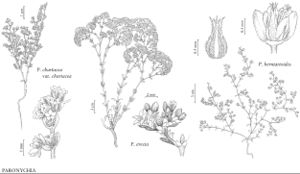Paronychia herniarioides
Gen. N. Amer. Pl. 1: 159. 1818.
Plants annual, matted; taproot filiform. Stems prostrate to erect, dichotomously branched, 3–20 cm, retrorsely to spreading- pubescent throughout. Leaves: stipules ovate-lanceolate, 0.5–7 mm, apex acuminate, entire; blade elliptic to oblong or ovate, or basal ones spatulate, 2–18 × 1–6 mm, herbaceous to leathery, apex mucronate to short-spine-tipped, moderately antrorsely pubescent. Inflorescences diffuse, flowers solitary (paired) in axils of leafy bracts. Flowers 5-merous, broadly ovoid, with enlarged hypanthium and calyx tapering distally, 2–2.3 mm, glabrous to strigose; sepals brownish to yellowish, veins absent, subulate to lanceolate, 1–1.7 mm, leathery to rigid, margins whitish, 0.03–0.1 mm wide, papery, apex terminated by awn, hood obscure, small flange, awn straight to slightly divergent, yellow, 0.3–0.4 mm, scabrous to antrorsely strigose, spinose; staminodes narrowly triangular, 0.2–0.3 mm; style 1, cleft in distal 1/8, 0.7–0.9 mm. Utricles ellipsoid to subglobose, 0.5–0.8 mm, essentially smooth, glabrous.
Phenology: Flowering spring–fall.
Habitat: Sandy ridges, dunes, pine/oak woodland
Elevation: 0-300 m
Distribution

Fla., Ga., N.C., S.C.
Discussion
Selected References
None.
